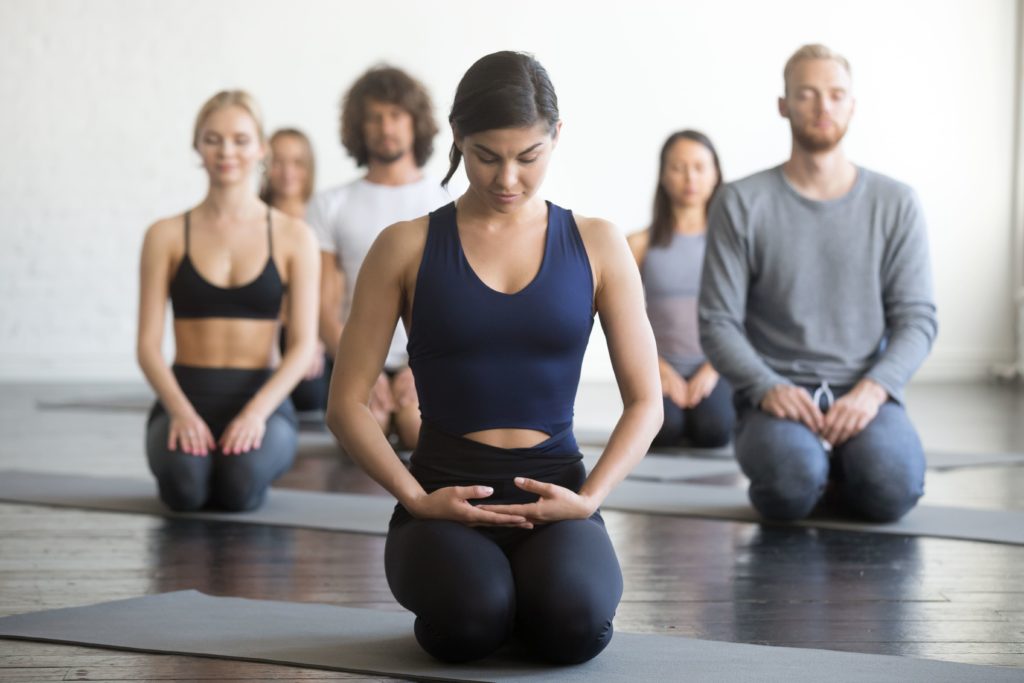Hello Yoga enthusiasts!
Welcome back as we embark upon a journey to learn more about the numerous benefits of Yoga. Yoga’s contribution to building and sustaining good health is unquestionable. (KNOW the various benefits of Yoga)
People practice Yoga for its immense benefits on their mental, spiritual, and physical wellbeing. Yoga teachings discuss the various Yoga postures, breathing techniques, meditation, and other techniques that can considerably improve our lifestyle. Yogic philosophy teaches the importance of good behavior, like ethics, morals, honesty, and respect. Ancient literature on Yoga discusses the significance of Yogic practices in enhancing one’s spiritual health. (READ how Pranayama aids in one’s spiritual wellbeing)
India is the birthplace of Yoga, where it was practiced for many centuries before its popularity soared. Yoga enjoys global fandom and has transformed many lives positively. Most people take up Yoga to develop a robust physique and improve their physical fitness.
Yoga postures act effectively on almost every muscle and organ of the human body. This blog will discuss the Yoga postures that strengthen the pelvic floor and improve pelvic posture.
Yoga Postures For Pelvic Muscles
1. Utkatasana
Utkatasana is a standing Yoga posture that requires you to squat and adequately engage your pelvic floor muscles.
- To start Utkatasana, stand with your feet spread apart, your back erect, and your shoulders drew backward.
- Inhale deeply and gradually draw your hips backward while exhaling.
- Bend your knees simultaneously, and pull your navel inside to tighten your abdominal muscles.
- Mimic sitting on a chair by bending your knees, so they are closer to the ground than your hips.
- Elevate both arms without bending the elbows and point the fingers towards the ceiling.
- Remain in Utkatasana pose for up to 10 breaths before relaxing your body.
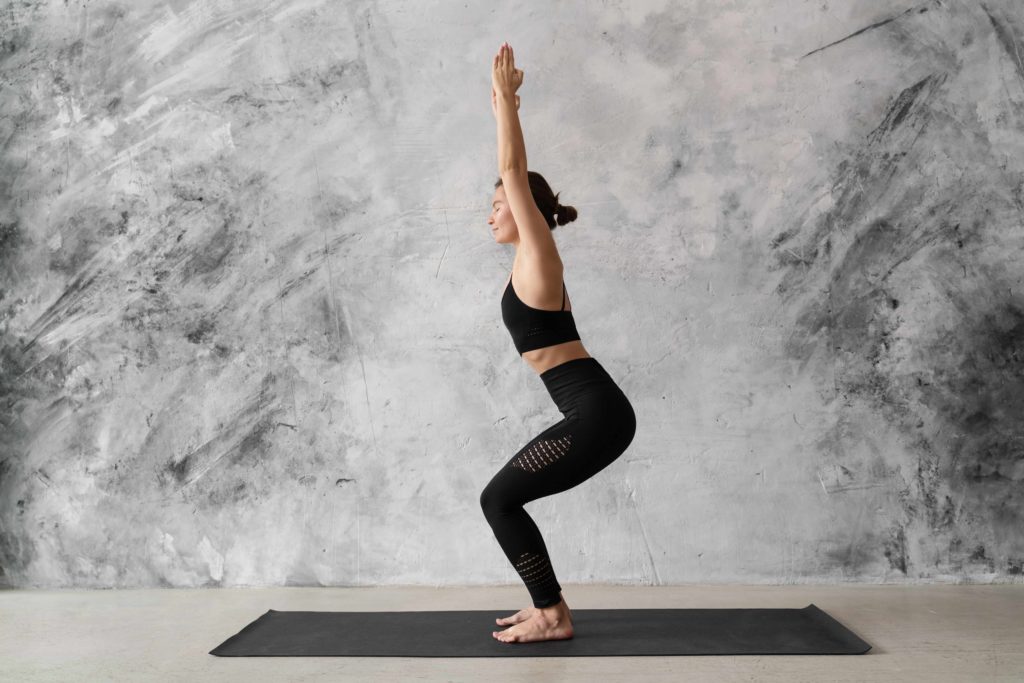
Utkatasana strengthens the pelvic floor muscles and releases unwanted mechanical pressure from the muscles. The posture is an excellent way to relax rigid lower back muscles, which add to the pelvic muscle tone. You may even practice the Mula Bandha and Uddiyana Bandha (READ about Yoga Bandhas) while in the Utkatasana pose. Utkatasana is a superior alternative to Kegel exercises that people commonly practice for a healthy pelvis.
2. Salabhasana
To perform the Locust Pose or Salabhasana, you must lie on the ground with your belly touching the floor. Salabhasana strengthens almost every muscle from head to toe, including the pelvic floor.
- Lie down with your chest, belly, and upper and lower limbs in complete contact with the floor.
- Bring your feet together so the ankles are fully extended, and the toes point in one direction.
- Interlock your fingers and keep your arms afloat without bending the elbows.
- Elevate your head, neck, shoulders, and chest till you can look straight ahead.
- Arch your neck and upper back slightly to avoid muscle strain.
- Now elevate your legs slightly off the floor without bending your knees or extending your hips.
- Remain in the Locust pose for 5-10 breaths before relaxing your body.
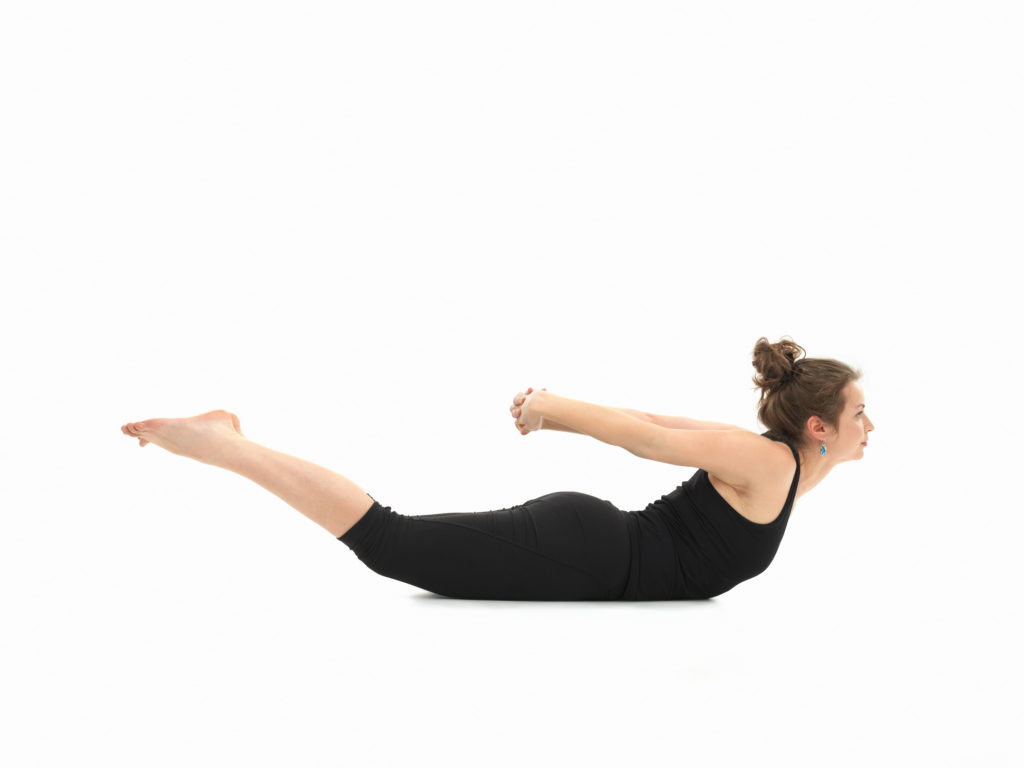
The Locust pose tones the gluteal, lower back, and pelvic floor muscles. Toned gluteal muscles counter-balance the pelvic muscles, which makes the pelvic floor more robust and flexible. Salabhasana strengthens the uterine and urinary bladder muscles, making it suitable to counter post-partum urinary incontinence.
3. Virabhadrasana
The warrior pose, or Virabhadrasana, is known for toning the limb muscles. However, the pose is also a great way to open the pelvis and tone its muscles. Let us learn one of the two variations of the Virabhadrasana that is more effective in strengthening the pelvic floor.
- Stand with your feet wide apart and place your hands on your hips.
- Elevate your arms till they are parallel to the floor and stretch them sideways.
- Turn your right foot outward by an angle of 90 degrees and rotate your left foot slightly inward to face the right heel.
- Bend the right knee so that it is level with your right foot and your right thigh is parallel to the floor.
- Stretch your left leg without bending it in the knee.
- Stretch your right arm forward and left arm backward, respectively, and stare directly ahead of the fingertips of your right hand.
- Do not bend your spine or slump your shoulders.
- Remain in Virabhadrasana for 5-10 breathing cycles and repeat the pose with your left leg.
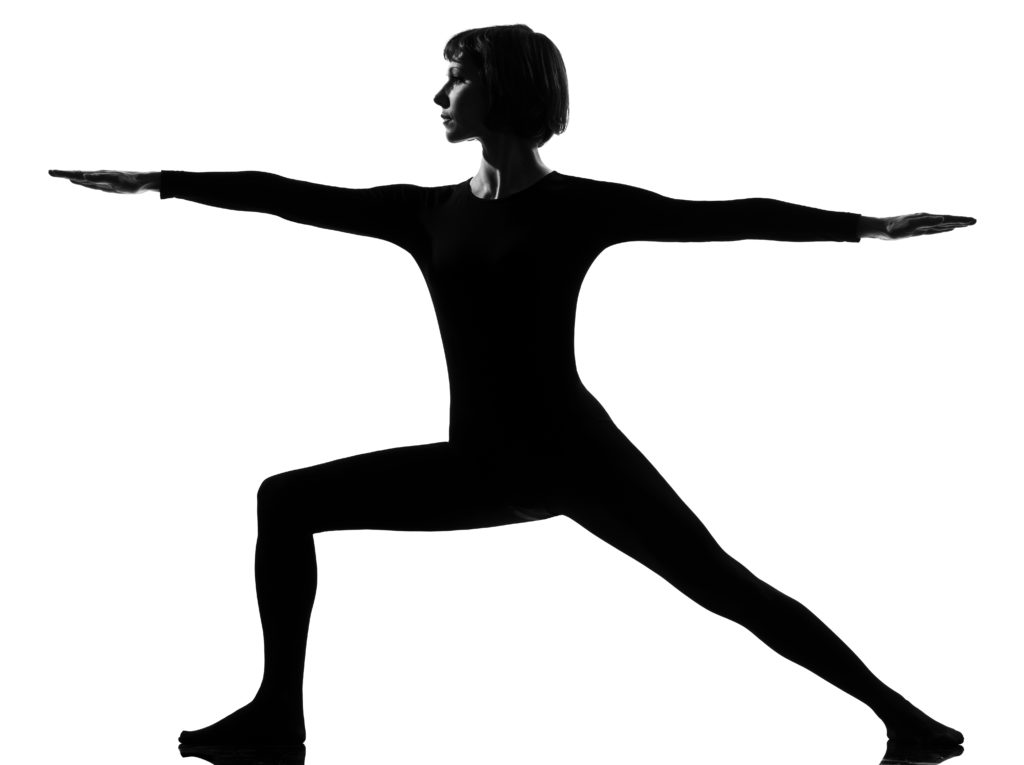
The second variation of Virabhadrasana adequately stretches and strengthens your pelvic muscles. The posture also acts on your urinary bladder and prevents urinary incontinence.
4. Malasana
Mala means ‘necklace.’ Malasana derives its name from the arrangement of the arms during the asana, which resembles a necklace. It is a squatting Yoga pose recommended to strengthen the hips and pelvis during pregnancy.
- Stand on a flat and firm floor with your legs close to one another.
- Your spine must be erect, your shoulders should be retracted, and you are not bending your elbows or knees.
- Squat gently without jerky movements or resting your buttocks on the floor.
- Spread your thighs outward and push your torso slightly to the front so that it is nestled between the thighs.
- Join your palms in prayer and place them in front of your chest.
- Press your elbows against your thighs and create resistance between the both. This action creates adequate stretching and pressure for your pelvic muscles.
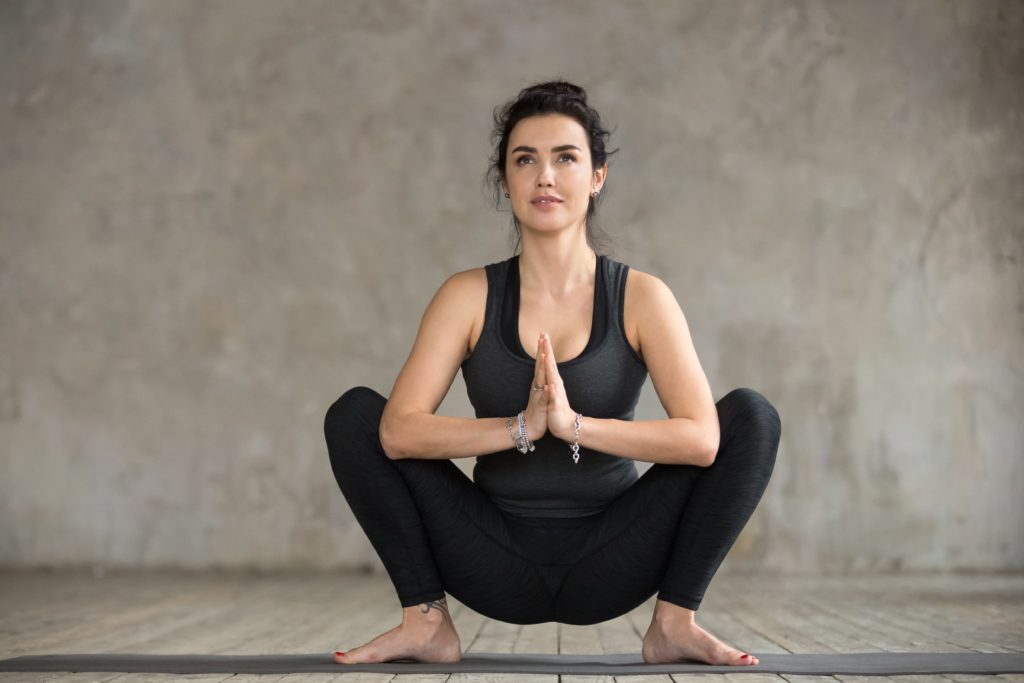
Remain in Malasana for at least 30 seconds before relaxing the posture. Malasana stretches and tones the inner thigh muscles, groins, and torso. The Yoga posture strengthens the lumbar muscles that also support the pelvic floor.
5. Setu Bandhasana
Setu Bandhasana, also known as Setu Bandha Sarvangasana, is one of the most popular lying-down Yoga poses. Setu means ‘bridge,’ bandha means ‘lock,’ and sarvanga means ‘all the limbs.’ One must lock their limbs in a bridge-like structure while performing the Setu Bandhasana.
- Lie down on your back with your limbs relaxing by the side of your body.
- Bend both knees till your ankles are touching your buttocks.
- Press your feet firmly to the ground and elevate your lower body and torso.
- Bring your hands together and clasp your fingers beneath your arched torso.
- In the final pose of Setu Bandhasana, balance your body weight on both feet, arms, and shoulders.
- Do not elevate your head and neck during Setu Bandhasana.
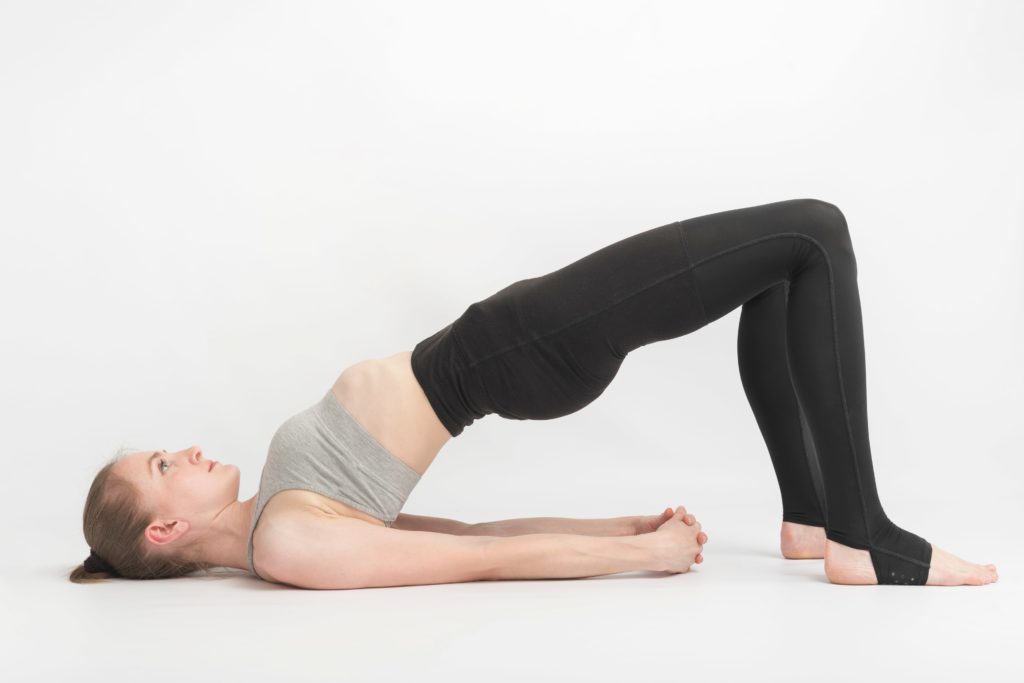
You can remain in Setu Bandhasana for 5-10 breaths before relaxing your body. Setu Bandhasana strengthens and tones the pelvic muscles and your lower back.
Functions Of The Pelvic Floor
Now that we are familiar with the Yoga poses that strengthen your pelvic muscles let us know how the pelvic floor affects our physiology. The pelvic floor is a hemispherical arrangement of muscles that encloses the terminal portion of the digestive tract, urinary organs, and female reproductive organs. A robust and healthy pelvic floor maintains the normal functions of all the organs it encloses.
Mentioned below are some essential pelvic floor functions.
- Voluntary Bladder Control
Your urinary bladder stores all the urine the kidneys form and excrete through the urethra. The pelvic floor muscles control the contraction and relaxation of the bladder during urination. A weakened pelvic floor will support your urinary bladder inadequately, which could lead to health issues like bed-wetting, urinary incontinence, and painful urination.
- Defecation
Defecation is one of the essential functions of the digestive system. The rectum, which eliminates fecal matter from your body, is a part of the pelvic cavity. The pelvic floor offers mechanical support to the rectum and regulates its actions. A healthy pelvic floor prevents constipation, rectal prolapse, and hemorrhoids.
- Female Sexual Wellness
The pelvic floor encloses female reproductive organs like the uterus, cervix, and vagina. A healthy pelvic floor strengthens the three organs and maintains a woman’s sexual health. The pelvic floor plays a crucial role during conceiving and carrying a pregnancy to full term. The female pelvis is designed differently than the male pelvis to facilitate childbirth. Pregnant women can safely perform Yoga to strengthen their pelvis to prepare for birth. (READ about the importance of Yoga during pregnancy.)
A strong pelvic floor is imperative to strengthen your lower back and develop good spinal posture. Yoga is one of the best ways to do so. However, Yoga cannot replace mainstream medical or surgical treatment for any health issue. You should see your physician if you battle any ongoing or chronic pelvic floor disorders.
Yoga is the best gift you can give to yourself to enjoy a healthy life!


